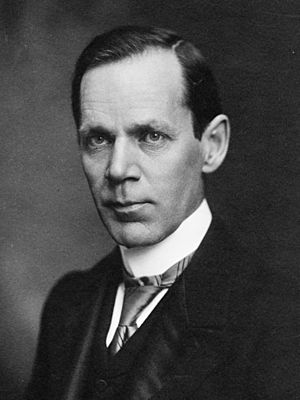Richard Cockburn Maclaurin facts for kids
Quick facts for kids
Richard Cockburn Maclaurin
|
|
|---|---|

Maclaurin in 1910
|
|
| 6th President of the Massachusetts Institute of Technology | |
| In office 1909–1920 |
|
| Preceded by | Arthur Amos Noyes (acting) |
| Succeeded by | Elihu Thomson (acting) |
| Personal details | |
| Born | June 5, 1870 Selkirk, Scotland |
| Died | January 15, 1920 (aged 49) Cambridge, Massachusetts |
| Alma mater | Auckland University College (B.Sc. (Hons), Mathematics, 1890) BA, 1895 (12th wrangler); LL.D., 1904, St John's College, University of Cambridge. |
| Awards | Smith's Prize (1898) |
Richard Cockburn Maclaurin (June 5, 1870 – January 15, 1920) was an important educator and scientist. He was born in Scotland but later became a U.S. citizen. He was a mathematical physicist, which means he studied how math and physics work together.
Maclaurin is best known for being the president of the MIT. He started this job in 1909 and stayed until he passed away in 1920. During his time as president, he made a big change for MIT.
Contents
Moving MIT: A New Campus
One of Richard Maclaurin's biggest achievements was moving MIT to a new, larger campus. The school used to be in Boston. But under his leadership, it moved across the Charles River to its current home in Cambridge. This new campus allowed MIT to grow and become even more famous.
To honor his work, some of the oldest buildings at MIT are sometimes called the Maclaurin Buildings. These buildings are found around a central area known as Killian Court.
Maclaurin's Early Career
Before leading MIT, Maclaurin had a successful career in education. From 1899 to 1907, he was a founding professor at Victoria College in New Zealand. This college was part of the University of New Zealand. Today, some lecture halls at that university are named after him.
He also taught at Columbia University in the United States from 1907 to 1908.
Who Was Richard Maclaurin?
Richard Maclaurin was born in Scotland. He was related to a famous Scottish mathematician named Colin Maclaurin. When Richard was only four years old, his family moved to New Zealand.
In 1904, he married Alice Young, who was from Auckland, New Zealand. They had two sons together. Richard's brother, James Scott Maclaurin, was also a notable scientist. James was a chemist who invented a special way to get gold using cyanide.
How Did Maclaurin Get His Education?
Richard Maclaurin was a very bright student. Here are some of his educational achievements:
- In 1887, he earned a University Entrance Scholar award from Auckland Grammar School.
- In 1890, he earned a Bachelor of Science (with Honors) in Mathematics from Auckland University College.
- He also studied at St John's College, University of Cambridge in England. He earned a Bachelor of Arts (BA) degree in 1895. He was known as the 12th wrangler, which means he was one of the top math students in his year.
- In 1904, he received an honorary Doctor of Laws (LL.D.) degree from the University of Cambridge.
Awards and Recognitions
Richard Maclaurin received several important awards for his academic work:
- He won the Smith's Prize in Mathematics in 1896. This is a very respected award for young mathematicians at Cambridge University.
- He also won the Yorke Prize in Law from the University of Cambridge in 1898.

